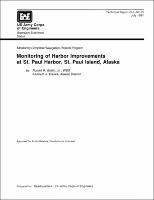Please use this identifier to cite or link to this item:
https://hdl.handle.net/11681/7432Full metadata record
| DC Field | Value | Language |
|---|---|---|
| dc.contributor | United States. Army. Corps of Engineers. Alaska District | - |
| dc.contributor | Monitoring Completed Navigation Projects Program (U.S.) | - |
| dc.contributor.author | Bottin, Robert R. | - |
| dc.contributor.author | Eisses, Kenneth J. | - |
| dc.date.accessioned | 2016-05-06T14:32:35Z | - |
| dc.date.available | 2016-05-06T14:32:35Z | - |
| dc.date.issued | 1997-07 | - |
| dc.identifier.uri | http://hdl.handle.net/11681/7432 | - |
| dc.description | Technical Report | - |
| dc.description | Abstract: In 1992, St. Paul Harbor,was approved for inclusion in the Monitoring Completed Navigation Projects Program. The objective of the monitoring plan for St. Paul Harbor was to determine if the harbor and its structures were performing (both functionally and structurally) as predicted by model studies used in the project design. Monitoring of the harbor was conducted during the period July 1993 through June 1996. Elements of the monitoring program included prototype wave gauging, wave hindcast study, wave runup, wave overtopping, bathymetric analysis, broken armor unit surveys, and photogrammetric analysis. Wave height data obtained inside the harbor appeared to validate a previous three-dimensional model study. A videotape analysis used to obtain wave runup data along the face of the St. Paul Harbor main breakwater was successful, except during periods of low visibility. Trends in wave hindcast data obtained outside the harbor correlated reasonably well with runup data in a qualitative sense. Absolute values of the hindcast significant wave heights, however, appeared to be substantially lower than the waves experienced in the prototype based on runup values measured, overtopping observed, and local forecasts. Although the St. Paul Harbor main breakwater is currently functioning in an acceptable manner and is in good condition structurally, armor stone continues to degrade. Continued deterioration is predicted due to freeze-thaw and wet-dry cycles as well as large waves and sea ice action. Photogrammetric analysis revealed most of the breakwater extension was below its design elevation. | - |
| dc.publisher | Coastal and Hydraulics Laboratory (U.S.) | - |
| dc.publisher | Engineer Research and Development Center (U.S.) | - |
| dc.relation | http://acwc.sdp.sirsi.net/client/en_US/search/asset/1000516 | - |
| dc.relation.ispartofseries | Technical report (U.S. Army Engineer Waterways Experiment Station) ; CHL-97-13. | - |
| dc.rights | Approved for public release; distribution is unlimited. | - |
| dc.source | This Digital Resource was created from scans of the Print Resource | - |
| dc.subject | Broken armor unit survey | - |
| dc.subject | Monitoring Completed Navigation Projects Program | - |
| dc.subject | Photogrammetry | - |
| dc.subject | St. Paul Harbor, Alaska | - |
| dc.subject | Wave runup and overtopping | - |
| dc.title | Monitoring of harbor improvements at St. Paul Harbor, St. Paul Island, Alaska | - |
| dc.type | Report | en_US |
| Appears in Collections: | Technical Report | |
